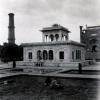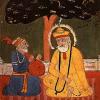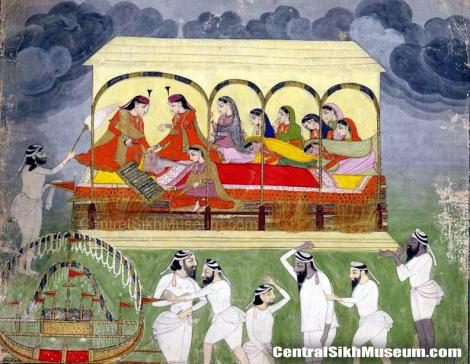Search the Community
Showing results for tags 'maharaja ranjit singh'.
-
Think his death anniversary is coming up according to the calendar. Here are some eyewitness accounts of his funeral, i read them years ago and the sati part left me thinking about it for several days! just horrifying! But as the historical accounts state the queens and slave girls actually decided to become sati! they were even discouraged but they insisted on becoming sati. The queens that became sati were Rajput women so its no surprise that they became sati as it was considered a very honorable thing in that community, In fact when the news reached one of the Rajput queens fathers kingdom that she became sati, her father was so proud of her heroic act that he ordered a celebration in honor of her bravery! her father even ordered a painting to be done depicting his daughter becoming sati! Maharani Jind Kaur famously said that she won't become sati. This sati incident is often used as a criticism and as hypocrisy because Sikhi is against this act, but the women that became sati were Rajput women! and it was part if their culture, Rajput women actually chose to become sati as it was considered very heroic in their culture . The 7 dancing girls that committed sati were Kashmiri. The Ranis that became sati were Mehtab Devi, daughter of Raja Sansad Chand of Kangr. Rani Har Devi, the daughter of Chaudhri Ram, a Saleria Rajput. Rani Raj Devi Rani Rajno Devi "Early in the morning subsequent to that on which the death of the maharajah happened, I went down the Tukht (coronation-square), accompanied by Col. Henry Steinbach (lately in the service of the maharajah, Gholab Sing, in Cashmere, now in Europe), and we directed our steps towards the large yard, which we had to cross, in order to get betimes to a convenient place close to the funeral pile. This was erected between the walls and the fortress, in a small garden, the conflux of the people having been so enormous in the fortress. In the large yard, we observed one of the four ranees (queens) coming out of the harem on foot and unveiled, for the first time in her life. She was slowly proceeding towards the place where the royal body was lying, and she was surrounded by about one hundred persons, who kept themselves at some distance, while accompanying her. Close to her side there was a man carrying a small box, containing the remainder of her jewels (as she had already distributed some ), which she made presents of, handing them one by one to the people on her right and left. Two or three steps in front of her, there was a man moving in a backward direction, his face turned towards her, and holding a looking-glass, that she might convince herself that her features were unaltered, and no fear visible on them. At the distribution of the jewels, Col. Steinbach made the observation that, had we stretched out our hands to receive a present, it certainly would not have been denied; but we thought proper to leave it to the poorer people, because we occupied lucrative posts. It is curious, indeed, that this was the very ranee whom Runjeet Sing married in the first year of my residence in that country, ten years having passed since I witnessed the nuptials at Nadoun. She was, as I mentioned before, a daughter of Sunsarchund, and she had a younger sister, whom the maharajah at the same time took also for a wife, and conveyed them both to Lahore; the latter, I am told, had died of consumption during my absence. As for the former, although I was present at her wedding, I nevertheless had never seen her before, and it was only on her last fatal walk, which she took to her funeral pile, that I could behold her. The funeral train, accompanied by many thousands of spectators, was now proceeding; all were on foot, their abode in the fortress not being far distant from the place of the ceremony. The four ranees only were carried, in open palanquins, behind the deceased, after them followed the seven female slaves, barefooted; some of them appeared to be not more than fourteen or fifteen years of age. The ranees, too, were barefooted, their silk dresses were simple, and without any ornaments, and they appeared to be indifferent to the awful though voluntary fate which awaited them. Perhaps our hearts throbbed more at the view of this dismal train than those of the poor victims themselves. The body of Runjeet Sing was placed on a board, to which it was probably fastened, and was carried on a light and decorated bier constructed in the shape of a ship; the sails and flags of the vessel were made of rich golden and silk stuff (kimkab), and of Cashmere shawls. A number of people carried the bier from the interior of the fortress up to the funeral-pile, there the board with the body was taken out of it and deposited on the ground, where, on what was a small garden, now stands a summood, i.e., a tomb of the royal family Runjeet Sing, Kurruck Sing and No-Nehal Sing, i.e., the father, son, and grand-child, together with their wives and slaves. The costly ornaments of the richly decorated bier were given to the mob; the Brahmins performed their prayers from the Shaater, a book written in the Indian or Sanscrit language; the Gooroos, or priests of the Sikhs, did the same, from their holy scripture called Grunthsaheb, and the Musselmen accompanied them with their “Ya, Allah! Ya, Allah!” A slow, but not displeasing rumbling of the drums, and the murmuring of the people, gave to the whole scene a melancholy aspect, and was peculiar to the country. The funeral pile which displayed itself before the eyes of the spectators, was constructed of dry woods, amongst which there were pieces of aloe; it was about six feet high and square. After the prayers of the Brahmins and Gooroos, which lasted nearly an hour, the minister and other sirdars ascended by a ladder the funeral-pile, upon which ignitible matters and substances, as cotton seeds, &c., were strewn, and the royal body was respectfully placed in the middle of the pile, together with the board. After this, the ranees ascended the fatal ladder, one by one, according to their rank, the slaves followed, and the minister showed himself very officious in affording them assistance. The ranees placed themselves at the head of the royal body, and the slaves close at its feet. There they cowered, remaining in silent expectation for the fatal moment, when a strong thick mat of reeds being brought, with which the whole were covered, oil was then poured over the mat, the minister and sirdars descended, and the pile was lighted at each corner. In a few moments, the deplorable victims of an abominable and fanatic ceremony had ceased to exist" ..................................................................................................................... “The funeral obsequies of this extraordinary man were too remarkable not to be mentioned here. Upon his death being made public, the whole of the Sikh Sirdars at Lahore assembled to do honour to his suttee, and four of his favourite queens, together with seven female slaves, having, in conformity with the horrible practice of the country, expressed their intention of burning themselves upon the funeral pyre, preparations were immediately made for the solemnity. It is said that much dissuasion is exercised in cases of suttee; ostensibly such may be the case; but in private every argument to the contrary is made use of by the relatives of the wretched victim, and the promise once given cannot be retracted. A street of a double line of infantry having been formed, the procession proceeded at a slow pace to its destination, only a quarter of a mile distant, and within the precincts of the palace. The corpse of the late Maharaja, placed upon a splendidly gilt car, constructed in the form of a ship, with sails of gilt cloth to waft him (according to native superstition) into paradise, was borne upon the shoulders of soldiers, preceded by a body of native musicians, playing their wild and melancholy airs. His four queens, dressed in their most sumptuous apparel, then followed, each in a separate gilt chair, borne upon the shoulders of their attendants; the female slaves following on foot. Before each of the queens was carried a large mirror, and gilt parasol, the emblems of their rank. After them came the successor to the throne, the Maharaja Kurruck Singh, attended by the whole of the Sikh Sirdara, barefooted, and clothed in white; none but persons of noble rank permitted to join the procession. To the last moment of this terrible sacrifice, the queens exhibited the most perfect equanimity; far from evincing any dread of the terrible death which awaited them, they appeared in a high state of excitement, and ascended the funeral pile with alacrity. The slaves also appeared perfectly resigned, but less enthusiastic. The body of the Maharaja having been placed upon the pile, his queens seated themselves around it, when the whole were covered over a canopy of the most costly Kashmiri shawls. The Maharaja Kurruck Singh then taking a lighted torch in hand pronounced a short prayer, set fire to the pile, and in an instant the whole mass, being composed of very ignitable material, was in flames. The noise from the drums and shouts of the spectators immediately drowned any exclamation from the wretched victims.” ..................................................................... The painting that Rani Mehtab Devi's father, Maharaja of Kangra proudly ordered an artist to do!
-
https://timesofindia.indiatimes.com/city/chandigarh/Maharaja-Ranjit-Singhs-only-photo-that-never-was/articleshow/26334700.cms
-
Brits would have lost to Sikhs, ‘but for treachery by 2 Gens’ William Dalrymple (right) speaks as (L-R) Amar Pal Sidhu, Mandeep Rai and Dr Sukhmani Riar look on at the Military Literature Festival in Chandigarh on Saturday. TRIBUNE PHOTO: RAVI KUMAR Ajay Banerjee Tribune News Service Chandigarh, December 9 Adept in Indo-British history, two leading historians today differed on what could have been the British Empire’s future after the First Anglo-Sikh War in 1846, but both agreed that the East India Company-led army had almost lost the war had the Sikhs — surprisingly or prompted by the treachery of two Generals — not surrendered. Speaking on ‘Anglo-Sikh wars’ at the Military Literature Festival here, London-based historian Amar Pal Sidhu argued: “The British lacked ammunition, had no water and were, thus, incapable of fighting. Then Governor General Lord Henry Hardinge was in the battlefield and he would have had to surrender. The entire British Raj could have collapsed.” Sidhu, who has authored separate books on the first and the Second Anglo-Sikh War (1848-49), said: “Had the Sikh army not surrendered, the British Empire’s history in India would have been different. It would have been a seminal moment resembling the one at Waterloo (where Napoleon Bonaparte of France lost).” The treachery by Generals Tej Singh and Lal Singh changed the course of history. The two owed their positions to Maharani Jindan, one of the queens of Maharaja Ranjit Singh. “Punjab probably would have been united and would still be united,” said Sidhu. William Dalrymple, author of “Return of a King: The Battle for Afghanistan”, accepted that the military edge in the First Anglo-Sikh War was with the Sikhs. He, however, differed on the outcome of the British Empire had they (Sikhs) won the first war. “At that point, it was easy to defeat the Company-led army, though they could have used their backup of vast resources and men,” he averred. They had resources much bigger than Punjab’s. Between 1790 and the early 1800s, the company was earning hugely from Bengal. The private army of the East India Company was twice the size of the British army. Mandeep Rai, who was moderating the session, said: “Historians have not realised that had the Sikh army not surrendered, the Lahore durbar would have survived and the state of Pakistan would not have come into being.” Dr Sukhmani Riar, Professor of history at PU, asserted that “the creation of the Dogra state (now J&K) after the First Anglo-Sikh War was still a mystery. How the Sikh kingdom collapsed within a few years of the death of Ranjit Singh (in 1839) is a matter of study”. The First Anglo-Sikh War led to signing of the ‘Treaty of Umritsar’ (Amritsar) and carving out a separate Dogra kingdom. It meant partial subjugation. Three years later, the Second Anglo-Sikh War led to total defeat of the Sikh army and the subsequent collapse of the Sikh kingdom.
- 8 replies
-
- british empire
- british indian empire
- (and 6 more)
-
Herbert art gallery and museum in Coventry are having an exhibition showing the heritage of Punjab and the throne of Maharaja Ranjit Singh ji. It will be on upto the 18th of January next year. https://www.justgiving.com/campaigns/charity/culturecoventry/craftsofthepunjab
- 1 reply
-
- maharaja ranjit singh
- punjab
-
(and 1 more)
Tagged with:
-
Guru Hargobind Sahib decreed long ago that the highest temporal authority for his Sikhs was to be Sri Akaal Takhat Sahib. Later, his grandson Sri Guru Gobind Singh proclaimed that the ascendancy of the Panth was second only to that of Guru Granth Sahib. Did Maharaja Ranjit Singh violate the democratic spirit of our Gurus' injunctions when he established himself as an absolute monarch and a temporal power to rival Sri Akaal Takhat, the representative body of the Panth? It bears mentioning that in spite of his being emperor of Sarkar-Khalsa, the Maharaja often deferred to the judgement of Akali Phula Singh and dutifully responded to Akali Ji's Hukamnama after being declared an apostate for marrying a Muslim dancing woman. On the other hand, it was precisely this system of feudal aristocracy/monarchy that encompassed the eventual ruin of the Sikh Empire. Wily villains like the Dogras and the Brahmin generals who sold out the Khalsa army during the First Anglo-Sikh War would never have attained prominence if not for this system of nobles and royal courts. Secondly, how should Sikhs feel about contemporary monarchs, particularly in those nations where we exist as their nominal subjects (the United Kingdom, and technically Canada, Australia, New Zealand)? I'll confess that I've a hard time comprehending the hysteria that surrounds the Windsors, and I'm unsure if it's becoming for a Sikh to grovel and make propitiations before anyone except our Guru.
- 8 replies
-
- maharaja ranjit singh
- monarchy
-
(and 2 more)
Tagged with:
-
http://dailysikhupdates.com/historical-weapons-maharaja-ranjit-singh-stolen-video/ I'm lost for words. It's a bloody good job the british took his golden throne, the kohinoor diamond and whatever else. Our heritage is being lost, looted and destroyed in punjab. At least the british have preserved what they took and made it available to the public.
- 11 replies
-
4
-
so was just wondering was he an amridhari? because of his living and lifestyle he doesn't seem to sound like one. he had 26 wives most were hindus, 2 were muslims, he had 100s of dancing girls in his harem and also drank a lot of home made alcohol, in fact it was the alcohol that led to a stroke. he also was proclaimed maharaja with the bagawad gita as witness. he also donated a lot to hindu temples aswell, which I think is anti- gurmat? so I was wondering how did he end up becoming the maharaja of the Sikh empire? I herd the akhalis and nihangs never really warmed up to him and his funeral as well, some of his wives became sati's even his muslim wife gul begum. how was this allowed to happen? his wives actually chose to do sati and were even asked twice. why didn't the akal takht people try to stop this? but have to say under his raj the arts of punjab really developed. its a shame that most Sikhs are unaware of their artistic heritage thanks a Sikh era painting depicting his funeral








